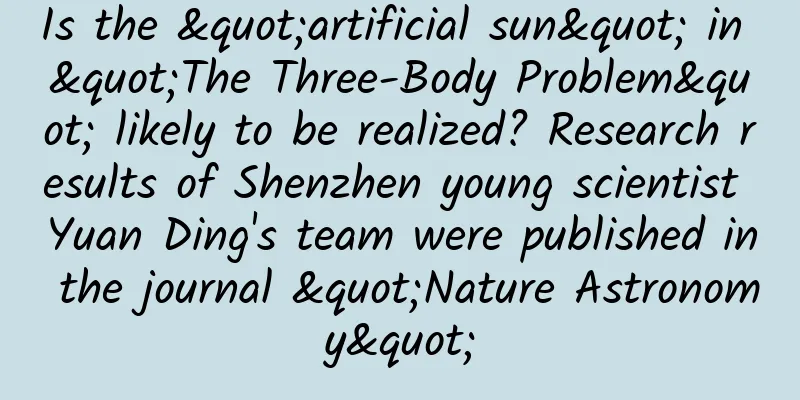How to measure the age of a star? It may not be as young as you think

|
Produced by: Science Popularization China Author: Guo Shuaishuai (Yunnan Astronomical Observatory, Chinese Academy of Sciences) Producer: China Science Expo Stars, those twinkling points of light in the universe, are a huge source of energy in the universe, but huge energy does not mean eternity. Stars have their own lifespans, and their age has become an important topic of research in the universe, because it not only concerns the fate of the stars themselves, but also affects the evolution of the universe. So, how do we measure the age of stars? Unlike our own age calculations, the calculation of stellar age relies on a complex set of physical processes and observational data. Astronomers have carefully studied the evolution of stars, observing their spectra, brightness, color and other characteristics, as well as their interactions with other interstellar matter. These observations and studies help us infer the age of stars. In modern astronomy, the rotation-age relationship has become one of the important methods for determining the age of stars . This theory is based on the relationship between the rotation speed and age of stars. By observing the rotation speed of stars, we can infer their age . However, if there is a hot Jupiter near a star, will the age of the star still be accurate? Today, I will take this question with you to see how to determine the accurate age of a star in a hot Jupiter system. A star-forming region in the Large Magellanic Cloud (Image source: Wikipedia) How is the age of a star measured? Who decides? The age of stars has always been one of the focuses of astronomers. The rotation age law is an important law about the relationship between stellar rotation rate and stellar age, which was first proposed by astronomer Skumanich in 1972. This law describes how the rotation rate of a star changes as the star ages, thus providing a method to estimate the age of a star using its rotation rate. The law discovered by Schoeman is based on a series of observational data and theoretical analysis, focusing mainly on the evolution of the rotation rate of stars over time. His research showed that in the early days of a star, the rotation rate is very fast, but as time goes by, the rotation rate of the star gradually slows down. He summarized this phenomenon into a simple power law relationship, that is, the rotation rate of a star is inversely proportional to the square root of the star's age . This relationship means that as a star ages, its rotation rate decreases . Schoeman's discovery provides a method for estimating the age of stars based on their rotation rate. White dwarf: The end of a star's life (Photo source: Veer Gallery) Although the rotational age law proposed by Schoeman can provide relatively accurate age estimates in some cases, it is also necessary to consider the influence of other factors, such as the initial rotation rate, mass and metallic abundance of the star . For example, the lifespan of a star is closely related to its mass, with less massive stars generally living longer and more massive stars being shorter-lived . Still, the law provides an important reference point for studying stellar evolution and age. Distribution of rotation rate as a function of stellar mass (The horizontal axis is speed, the vertical axis is mass) (Image source: Chinese Academy of Sciences) More than 30 years later, Barnes of the Leibniz Institute for Astrophysics in Germany defined the correlation between stellar mass, stellar rotation rate and age through astronomical observations. When the observation accuracy is good enough, the calculation error of a single star can be controlled within 10%. However, the rotation-age relation does not apply to all stars, but generally applies to main-sequence stars in the mass range of 0.5 to 1.5 times the mass of the Sun. In this mass range, stars' rotation speeds slow down over time as they gradually lose angular momentum. This slowing down of rotation is related to the age of the star, with young stars rotating faster and old stars rotating slower. The researchers believe that this relationship may be caused by magnetic fields and convection motions within the stars . Leibniz Institute for Astrophysics Babelsberg Research Campus, Germany (Image source: Official website of the Leibniz Institute for Astrophysics in Germany) What are hot Jupiters and how do they relate to Jupiter? Earlier, we introduced how to get the age of a single star through its rotation. However, in our universe, many stars do not exist alone. They are similar to the solar system and have planets revolving around them to form a planetary system. These planets are of various types, forming a complex and diverse planetary system. Among them, hot Jupiters are very special, and their existence has challenged the theory of planet formation. Next, let's learn about this magical celestial body. NASA's Transiting Exoplanet Survey Satellite (TESS) team has discovered one of the most extreme ultra-hot Jupiters ever, one that can orbit its star in just 16 hours. (Image source: The Astronomical Journal) The first confirmed exoplanet was discovered in 1995 by two Swiss astronomers, Didier Queloz and Michel Mayor, for whom they were awarded the 2019 Nobel Prize in Physics. The planet, named 51 Pegasi b , is a hot Jupiter that orbits a sun-like star, 51 Pegasi, in the constellation Pegasus. The discovery has far-reaching implications, not only rethinking the diversity of planetary systems, but also opening a new era in the search for extrasolar planets. 51 Pegasus b is a gas giant planet similar to Jupiter, but its distance to its parent star 51 Pegasus is very close, much smaller than the distance between the Earth and the Sun. This distance is only 0.0527 times the distance between the Earth and the Sun. What does this mean? Artist's impression of the exoplanet 51 Pegasi b and its host star. (Image credit: ESO/M. Kornmesser/Nick Risinger) You should know that Mercury, the closest planet to the sun in our solar system, is 0.387 times the distance between the sun and the earth, which is 7 times that of Pegasus 51b. Such a close distance causes it to receive more stellar radiation, causing its surface temperature to reach more than 1000 degrees Celsius. Such a high temperature makes its atmosphere too expanded, and although its mass is half that of Jupiter, its volume is larger than that of Jupiter. To date, more than 200 hot Jupiters have been confirmed, most of which are in a tidally locked state, that is, one side of the hot Jupiter is always facing the star . However, the way this Jupiter-like giant planet orbits its parent star is inconsistent with scientists' previous theoretical predictions, because according to traditional theory, planets should be formed farther away from their parent stars. The innermost region of the planetary system can only accommodate terrestrial planets (such as Earth and Mars), while gas giants (such as Jupiter) can only form outside the "snow line". The "snow line" marks the great distances from stars where helium and hydrogen, the building blocks of giant star gas, can exist in a pristine disk of gas and dust without being blown away by radiation from stellar winds. Therefore, many astronomers prefer to believe that these hot Jupiters were also very far away from the sun when they were first formed, just like Jupiter in our solar system, and then migrated to their current positions in some way. (Top) Didier Queloz; (Bottom) Michel Mayor (Photo source: Xinhuanet) Now that we know what a hot Jupiter is, the most essential difference between it and Jupiter is also obvious. The key point is the "heat". The reason for the heat is that it is too close to the star and receives too much radiation from the star, causing its atmosphere to be heated to a very high temperature. The mysterious force that changes the rotation of stars: tidal forces We now know how astronomers can tell the age of a star from its rotation, and we also understand what hot Jupiters are. Now we return to the original question: for hot Jupiter systems, is the stellar age obtained from the rotation-age relationship still reliable? The answer is of course no. If the star and the planet are regarded as particles and the planetary orbit is regarded as a circular orbit, then the planet will move in a uniform circular motion around the star, and the orbital angular momentum of the planet will be conserved. However, in reality, celestial bodies will deform under the influence of gravity. At this time, the celestial bodies are not ideal uniform spheres. The orbits of the planets will change, and angular momentum will be transferred between the two celestial bodies. We will discuss this as simply as possible in the diagram below. First, gravity causes the body to deform, creating tidal bulges. Secondly, a celestial body can be viewed as two parts, one moving away from another and one moving closer to another. The part closer to another celestial body is subject to greater gravitational pull, while the part farther away from another celestial body is subject to less gravitational pull. For Figure 1, the rotation and revolution speeds are equal, and the direction of force on stars and planets is always pointing to the center, which means that there is no force in the horizontal direction, that is, there is no angular momentum transfer between stars and planets. (Image source: self-made by the author) For Figure 2, the star rotates faster than the planet revolves, so the star is always one phase ahead of the planet. At this time, the combined force of f1 and f2 acting on the planet has a component along the tangential direction of the revolution. This component causes the planet's orbit to rise. From Newton's law of universal gravitation, we can know that the revolution speed slows down. The combined force of the forces F1 and F2 on the star has a rightward component that slows down its rotation. This process can be understood as the transfer of the star's rotational angular momentum to the planetary orbit. (Image source: self-made by the author) However, Figure 3 is the opposite of Figure 2. The rotation speed of the star is slower than the revolution speed of the planet. Through the same analysis, we can see that the planetary orbit is lowered, the rotation of the star is accelerated, and the angular momentum is transferred from the planetary orbit to the star. (Image source: self-made by the author) To simply summarize these processes, the slow ones must be replenished by the fast ones . We also know from the stellar rotation-age relationship that the stellar rotation itself is gradually decreasing. The process of Figure 2 and Figure 1 will eventually transform into the process of Figure 2. The information currently provided by telescope observations also tells us that the stars in hot Jupiter systems generally rotate faster. This also tells us that for hot Jupiter systems, the stellar age obtained from the rotation-age relationship must be corrected. The revised results for WASP-19's age show that it appears to have become too "young". Recently, thanks to the efforts of researchers at the Yunnan Astronomical Observatory of the Chinese Academy of Sciences, the age of WASP-19 has been revised. The companion of this star is a hot Jupiter with a mass slightly larger than that of Jupiter and an orbital period of only 0.79 days. Such a close distance is likely to produce a strong tidal acceleration effect on the star's rotation. Calculations show that in extreme cases, the existence of this hot Jupiter can cause the actual age of a star of 10 billion years to be misestimated to be several hundred million years. Conclusion The determination of the age of stars requires astronomers to use various methods and theories, through observation, simulation and calculation, to continue to conduct in-depth research in order to reveal the mystery of the age of these cosmic lights. The exploration of the age of stars not only provides us with clues to understand the evolution of the universe, but also makes us more in awe of these twinkling cosmic pearls. They may have existed for billions of years, or they may gradually disappear in the long river of time in billions of years, but we can still understand their life cycles through their remaining temperature. The same is true for life. Just as the exploration of the age of stars reveals the mysteries of the universe, we should also cherish our limited lives. Since there is no eternity in this world, let us create, explore, love, and experience in our limited lives. Just as every star has its own story, we can also leave our own brilliant brilliance in the vast universe. |
<<: Why can I still eat dessert when I am already full? Do I really have another stomach?
Recommend
Check it out! It's not a "kitchen magic weapon" but a "time bomb"
"Gather the flame, save gas", "Ena...
Special planning of the "How Much Do You Know About Nutrition" series | One article explains everything related to high-quality protein
What is protein? Amino acids are the basic units ...
Project analysis: One order earns hundreds of profits, using the second-hand platform to do credit card rebate
Many veterans should know what project Feng Chao ...
Introducing 5 data-driven and practical customer acquisition methods
Admittedly, in many cases, the acquisition of new...
2018 World Cup User Behavior Insight Report: Messi and Ronaldo were the most discussed before the game
The 2018 Russia World Cup is here as scheduled! A...
Super data recovery money-making project, easily earn 10,000+ per month (with tutorial data recovery software cracked version collection)
I believe everyone has the experience of accident...
【Liu Heng Ma Yi Shen Xiang】 Teacher Liu Heng explains the twelve palaces of face reading in "Ma Yi Shen Xiang" and how to recognize people by their faces
【Liu Heng Ma Yi Shen Xiang】 Teacher Liu Heng expl...
A collection of Father’s Day poster copywriting, Durex is the best! !
For the upcoming Father's Day, many brands wi...
Recommend several useful Linux e-book readers (Part 1)
With the increasing number of handheld devices, p...
Introduction to vivo App Store CPD Promotion Platform
CPD Promotion Platform Introduction The vivo App ...
A 24-year-old boy fainted after having his teeth extracted and died after a craniotomy! Can wisdom teeth still be extracted?
Recently, #A 24-year-old boy fainted and died aft...
Intel Skylake i7-6700K overclocking test
Due to various reasons, Intel's recent genera...
Fan Gongzi's "White, Rich and Beautiful Girlfriend Plan" is the unprecedented and only strategy to attract white, rich and beautiful women
Course Catalog of Fan Gongzi's "White, R...
Chengming Taiyi Jiuku Tianzun Dharma Training Course (Seventh Session, March 2021)
Chengming Taiyi Jiuku Tianzun Dharma Training Cou...
Community disassembly | Looking at the process from attracting new users to converting users from the perspective of game groups
What is a community? How to define community? How...









